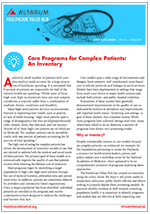Care Programs for Complex Patients: An Inventory
A relatively small number of patients with complex medical needs account for a large proportion of healthcare spending. It is estimated that 5 percent of patients are responsible for half of the nation’s healthcare spending.1 While some of these high-cost, high-need patients have rare and complex conditions, a majority suffer from a combination of multiple chronic conditions and disability.
Many high-need patients also face socioeconomic barriers to improving their health such as poverty or lack of stable housing.2 High-need patients span a range of demographics but they are disproportionately older, female, white, less educated, and low income.3 Almost all of these high-cost patients are on Medicare or Medicaid. The neediest patients can be incredibly costly with 1 percent of patients accounting for 23 percent of total spending.4
The high cost of caring for complex patients has driven the development of innovative models of care that are tailored to address both the medical and social needs of these patients. The primary goal of these models is to systematically improve the quality of care that patients receive while lowering the lifetime cost of treatment.
Most programs begin by identifying a target population of high-cost, high-need patients through the use of medical histories, utilization data and patient interviews. In addition, patients are sometimes referred by providers and community-based organizations. Once a target population has been identified, individual patients are enrolled in the program and receive customized services designed to address the challenges and barriers they face.
Care models span a wide range of interventions and designs, from intensive, well-coordinated, team-based care to referral protocols and linkages to social services. Models have been implemented in settings that range from small rural clinics to major health systems and include both private- and public-funded initiatives.
Evaluations of these models have generally demonstrated improvements in the quality of care as indicated by declines in utilization and improvements self-reported health status.5 Achieving cost savings—a goal of these models - has remained elusive. While some programs have achieved savings over time, many others have failed to do so. However, a number of programs have shown very promising results.
Why an Inventory?
Despite considerable interest in care models focused on complex patients—as evidenced, for example, by five foundations partnering to create the Playbook, a resource for health system leaders, payers, and policy makers and a workshop series by the National Academies of Medicine—there appeared to be no comprehensive inventory of programs deploying these approaches.
The Healthcare Value Hub has created an inventory using the rubric below. We hope it will prove useful to researchers, advocates, public health officials and others seeking to properly deploy these promising models. As payment models continue to shift towards rewarding population health, it is important to identify programs and models that are effective at both improving care for the highest-need patients while at the same time lowering the cost of care.
This Hub's inventory of state programs can be accessed at www.healthcarevaluehub.org/advocate-resources/complex-patients.
Inventory Methodology
In general, the Hub inventory of Social Medical Models includes programs that include these criteria:
(1) target a population that is high-need, complex OR high-cost,
(2) exhibit material involvement in meeting non-medical needs (medical-only models excluded), and
(3) is either ongoing or operated subsequent to 2000
NOTE: If a model has been replicated, we will profile a single location but note that it has been scaled and include a list of locations.
Programs were determined to have fulfilled criteria no. 1 if the program was specifically targeted to a sub-group within a population that was defined as high-cost, high-need, or medically complex by the program. Programs were also included if they targeted a specific condition or at-risk population, even if “high-need” was implied and not stated (for instance, programs targeting homeless individuals).
Programs were determined to have fulfilled criteria no. 2 if the program involved either a social worker or systematic referrals to or relationships with social programs (food, housing, employment, etc). Funding source and sustainability were not relevant factors. Programs did not have to be direct healthcare providers or payers to qualify. For instance, a charity that targets high-need homeless individuals and provides connections to healthcare resources would qualify, despite not directly providing or paying for healthcare services.
Broad population health programs, such as county-wide multi-stakeholder initiatives were not included, as they are not highly targeted.
Care coordination and management programs were medical-only and did not incorporate social services in some way were generally not included. Exceptions were made for medical-only models that are targeting individuals experiencing social disparities. For instance, Project ECHO does not provide social services but it does target a social disparity—rural location—and therefore qualifies as a social-medical model.
Missing A Program?
As the first ever effort to identify social-medical models of care for complex patients, we have may have overlooked a program. Please send us your additions, corrections and updates to amanda.hunt@altarum.org.
Notes
1. Cohen, Steven, and William Yu, “The Concentration and Persistence in the Level of Health Expenditures over Time: Estimates for the U.S. Population, 2008-2009,” Agency For Healthcare Quality and Research (2012)
2. Addressing the Unmet Medical and Social Needs of Complex Patients, Healthcare Value Hub, Research Brief No. 17 (February 201.
3. High-Cost High-Need Patients: Who Are They and How Do They Use Health Care, The Commonwealth Fund (Aug 29, 2016). Available at: http://www.commonwealthfund.org/publications/issue-briefs/2016/aug/high-need-high-cost-patients-meps1
4. Cohen, Steven, and William Yu, “The Concentration and Persistence in the Level of Health Expenditures over Time: Estimates for the U.S. Population, 2008-2009,” Agency For Healthcare Quality and Research (2012).
5. Addressing the Unmet Medical and Social Needs of Complex Patients, Healthcare Value Hub, Research Brief No. 17 (February 2017).







